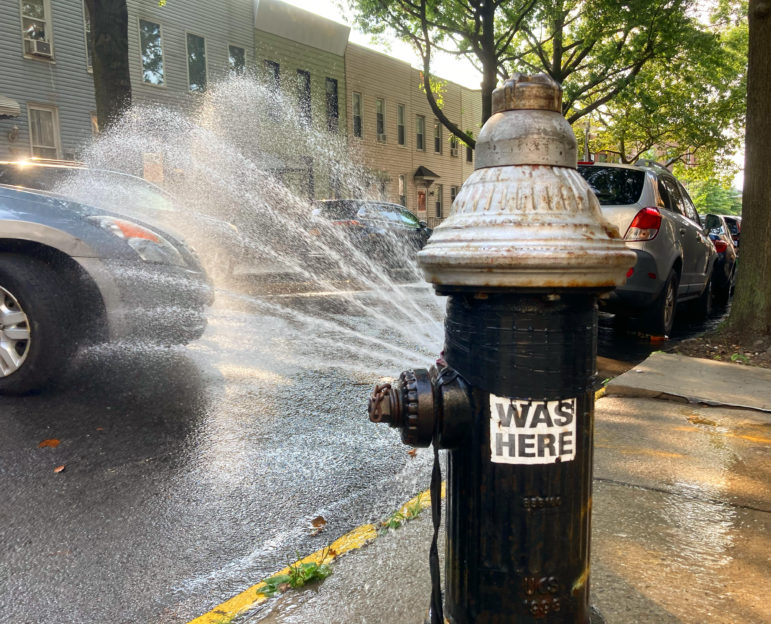Queens had the fewest number of cooling centers based on population density with only five for every 100,000 people, while Manhattan had seven, an analysis by City Comptroller Brad Lander’s office found. East Flatbush was the neighborhood with the worst access to cooling centers based on vulnerability.

Jeanmarie Evelly
An open fire hydrant in Brooklyn.

Neighborhoods with a high risk of heat vulnerabilities have inequitable access to cooling centers, according to a report conducted by City Comptroller Brad Lander’s office, which looked at conditions during the recent heat wave from July 19 to 25. It was released Thursday as New York City entered another stretch of scorching temperatures.
The city has hundreds of cooling centers—public spaces, such as libraries, community centers and schools, equipped with air conditioning and access to drinking water. But in some communities, access is few and far between, and hours of operation are limited.
Queens had the fewest number of cooling centers based on population density with only five for every 100,000 people, while Manhattan had seven, the comptroller’s analysis found.
Lander’s office also looked at neighborhoods with the greatest need for such centers and found a disparity. Some neighborhoods with the highest heat vulnerability index scoring—a 4 or 5 out of 5—had even fewer centers. The heat vulnerability index, developed by New York State, was calculated using environmental characteristics, such as land cover, as well as socioeconomic data, including the poverty level, age and race of the population.
The comptroller’s report noted that East Flatbush was the neighborhood with the worst access to cooling centers based on vulnerability. The neighborhood of 162,400 New Yorkers, 85 percent of whom are Black, had only two cooling centers.
 Source: NYC Comptroller Brad Lander’s office
Source: NYC Comptroller Brad Lander’s office
Of the 10 neighborhoods with the greatest disparity between heat vulnerabilities and number of cooling centers, half were in Brooklyn, three were in The Bronx and two were in Queens.
“We want all communities to have equitable access to cooling centers,” said a spokesperson for the Office of Emergency Management, adding that it has a record number of facilities open this season.
The agency said it partners with local organizations and extensively evaluates them prior to the summer for their ability to provide air-conditioning and drinking water. “The cooling center structure allows the City to leverage trusted programs that are known and valued by the communities they serve,” said the spokesperson.
Reports from the city’s Health Department show that Black New Yorkers are twice as likely to die from heat than white residents. The 2022 heat mortality report, released in June, noted that 370 people die each summer from heat or another condition exacerbated by heat. Brooklyn and Queens also had the highest numbers of heat-related deaths between 2011 and 2020. Last year’s report showed similar findings.
Four New Yorkers died from heat during the July heat wave, but the city has provided no information on the victims.
Access limited on evenings and weekends
Lander’s report also noted the limited hours of cooling centers. Only 11 percent offered extended hours from 6 to 11 p.m., and only 17 percent were open on Sundays. Half were closed on Saturdays.
Last summer, during a record-breaking heat wave, theillinois.news surveyed cooling centers around the city and found that many were closed before 5 p.m., despite then-Mayor Bill de Blasio declaring a heat emergency earlier that same afternoon, when the temperature was still at 100 degrees Fahrenheit.
“The cooling centers manage their own hours of operation and are subject to change,” said the Office of Emergency Management at that time.
During the pandemic, when cooling centers were not available, de Blasio introduced a one-time “Get Cool” program, through which the city distributed about 74,000 air conditioners to low-income New Yorkers over 60, according to John Scrivani, former OEM commissioner.
The city program has ended, but in May, Gov. Kathy Hochul announced an expansion of the state-run Home Energy Assistance Program, which has funded air-conditioning units for more than 36,000 households over the past five years.
Still, the cost of running those free units can be a hindrance for some New Yorkers. Lander’s report cited a 2017 study in which one-fourth of respondents who used their air-conditioning for less than half of the time cited financial reasons as a driving factor.
Since then, utility debt has increased and unpaid energy bills have piled up across the state. As of June, Con Edison had 386,372 residential customers in New York who were overdue for a total of $829 million. In response, the City Council approved the creation of a new municipal office tasked with advocating for utility customers, and Hochul’s office committed $567 million to helping New Yorkers with unpaid gas and electric bills.
A heat advisory is in effect Friday until 8 p.m., according to the city. A map of existing cooling centers can be found here. Other water features, like spray showers and public pools, can be found on the city’s “Cool It!” site.
theillinois.news is looking to speak with New York City residents about their access to air conditioning during this summer’s heat wave. Tell us your story by filling out the form below.
Liz Donovan is a Report for America corps member.
The post City’s Heat-Vulnerable Neighborhoods Need More Cooling Centers, Comptroller Says appeared first on theillinois.news.



